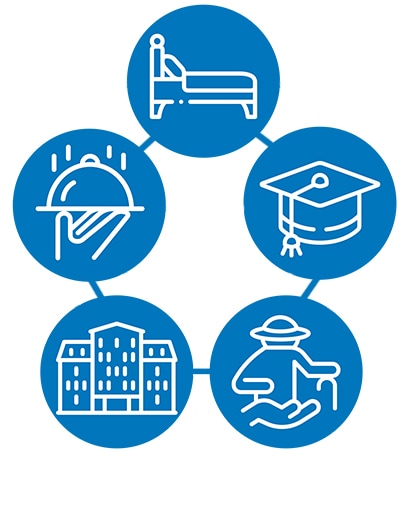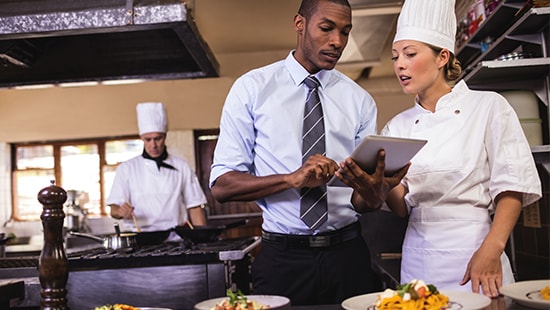Leveraging Your People to Get More From Digital Tools (and Digital Tools to Get More From Your People)
By Maarten Potjer, Executive Vice President of Innovation Growth Strategy at Ecolab

How Do You Get More From Less?
That was the question on the top of my mind at this year’s National Restaurant Association Show in Chicago. Plenty of current trends and macro factors make it seem like the more-from-less challenge is unique to the moment, but really, efficiency has always been the hallmark of a successful restaurant business. The big change is the way the best restaurants are using digital technologies to unlock a new level of efficiency and passion in their team.
I recently had the chance to talk about the challenges and opportunities of the moment as part of an education session at this year’s Restaurant Show, I shared Ecolab’s perspective on how restaurant leaders can make the most of both their human team and the next-gen digital tools available to them — to ultimately turn some of their biggest challenges on their heads and create competitive advantages.
A Familiar List of Top Restaurant Challenges
The panel began by asking for our thoughts on the biggest challenges in the industry right now — and, in particular, how those challenges compare to 10 or 20 years ago.
- Finding (and retaining) good employees: A decade or two ago, people in their late teens and early 20s would look to the restaurant industry to get a solid start, they now have a much broader horizon of job options: It’s much harder to get young people to work at a fryer when they can get higher pay at digital jobs working from home.
- Balancing off-premises dining: The rise in off-premise dining is another big challenge our team at Ecolab sees restaurants dealing with right now. While we’re obviously down from early pandemic levels, the stats clearly show this change is here to stay. See chart below.
- Pressure to leverage digital tools: Lastly, in our research, we hear a lot of frustration and anxiety around digital technologies. Whether it’s consumer demand for technologies like app-based ordering and self-service ordering kiosks or pressure from within the business to use digital tools to find efficiencies, make data-driven decisions and modernize operations.
The people we talk to know there’s value to be gained from these tools. But they don’t always have the time or digital-savvy staff to implement them — and use them well.

In 2019, off-premise sales for full-service restaurants accounted for only 10% of sales. From April until December of 2020, off-premises dining temporarily increased to 44% of all sales. Starting January 2021, and through the most recent data from 2023, off-premise sales stabilized at 25% of sales, representing a new normal level post-Covid that is 2.5 times the levels of off-premise sales seen pre-Covid. Data for Full-Service Restaurant Sales from “Nation’s Restaurant News”. July 2023.
Creating Synergy Between Your People and Your Digital Tools
With resounding agreement on the problems and pain points in front of restaurants right now, it’s time to turn to solutions.
First off, focus on simplification: menu simplification, process simplification, even simplification of the restaurant space. Simple is efficient, and simple empowers your people to be more productive.
On the efficiency side, more and more restaurants are using digital tools that leverage AI and analytics to sort through tremendous amounts of operational data to pull out patterns and trends, and make recommendations on how to improve restaurant efficiency. These trends and insights, without technology, can take a general manager years of experience, sometimes decades, to recognize.
An industry anecdote holds that you need to go through 10 years of pain before you’re a good restaurant manager. These tools are helping people get there much faster and with much less pain. The result is less stress, less frustration, and a more enjoyable and engaging experience for staff.
But these next-gen digital tools are also a tremendous opportunity to attract and engage younger workers to jobs in the restaurant business. Smart restaurant leaders are leveraging the skillset of digital-native younger generations — empowering them to use digital technology to gain knowledge and skills and engage them with more decision-making responsibilities.
A powerful combination: digital tools that unlock insights to improve your business, while also unlocking collaboration and engagement among younger employees.
Key to Success: Restaurants Need Digital Tools Purpose-Built for Their Industry
It’s exciting to see the proliferation of digital tools in the restaurant world. But it’s hard to figure out where to start and what tools to choose. We’ve heard more than a few stories of sour experiences with digital tools that didn’t deliver on their promised value.
The best advice we can give? When evaluating tech tools, you’re better off going with a vendor that started with a foundation of restaurant experience and then built a tech platform rather than a tech company that’s trying to figure out the restaurant industry.
We all know how complex the restaurant business is — how unique and interconnected the challenges are. You want a tech vendor that really understands how restaurants run. You want a purpose-built digital tool that gives you out-of-the-box functionality and the shortest path to ROI, so you (and your employees) are not stuck figuring out how to make a tool work in your restaurant.
“I focused on simplification: menu simplification, process simplification, even simplification of the restaurant space. Simple is efficient, and simple empowers your people to be more productive.”
– Maarten Potjer
Building Passion for The Restaurant Industry in The Next Generation
My favorite thing about events like the Restaurant Show is how they reinvigorate my passion for the restaurant industry — just being surrounded by people who love this business as much as we do.
In this regard, the most important takeaway from our session is that digital tools are not a replacement for human workers and human passion. Rather, restaurants should be looking at digital tools as a powerful way to cultivate that passion in the next generation. With the right digital tools, you can give younger workers an experience that’s more familiar to their digital-native lives. And you can give them insights that empower them to be more strategic and more data-driven, so they can take initiative and build passion earlier in their careers.




